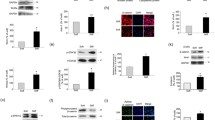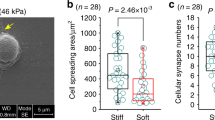Abstract
Matrix elasticity exerts considerable influence on the phenotype of terminally differentiated chondrocytes via physical cues. The Yes-associated protein (YAP) transcription co-activator is recognized as a key mediator that may be involved in the nuclear transduction of physical cues controlling cellular behavior and function. However, whether substrate elasticity in the regulation of the chondrocyte phenotype is associated with YAP remains unclear. In this work, we developed micropatterned substrates with varying stiffnesses to investigate the function of YAP and its related Hippo pathway kinases in the regulation of chondrocyte phenotype on soft and stiff substrates. We found that the phenotypic variation of chondrocytes in response to substrate stiffness is concomitant with the changes in YAP localization. The downregulation of YAP expression helps to maintain the chondrogenic phenotype while inhibiting chondrocyte proliferation. Furthermore, the change in the chondrocyte phenotype response to LATS1 kinase inactivation in the Hippo pathway varies significantly between soft and stiff substrates. We also found that LATS1 kinase inactivation promotes chondrocyte dedifferentiation only on stiff substrate. Collectively, these findings reveal that YAP may be involved in the changes that occur in chondrocytes cultured on substrates with different stiffnesses and that these changes do not entirely depend on the Hippo pathway kinase LATS1. Importantly, our findings indicate that YAP inactivation is conducive to the maintenance of the chondrogenic phenotype, thereby providing new insight into articular cartilage repair and regeneration mechanisms.




Similar content being viewed by others
References
Allen JL, Cooke ME, Alliston T (2012) ECM stiffness primes the TGFbeta pathway to promote chondrocyte differentiation. Mol Biol Cell 23(18):3731–3742
Brittberg M, Lindahl A, Nilsson A, Ohlsson C, Isaksson O, Peterson L (1994) Treatment of deep cartilage defects in the knee with autologous chondrocyte transplantation. N Engl J Med 331(14):889–895
Buckwalter JA (2002) Articular cartilage injuries. Clin Orthop Relat R 402:21–37
Buxboim A, Ivanovska IL, Discher DE (2010) Matrix elasticity, cytoskeletal forces and physics of the nucleus: how deeply do cells ‘feel’ outside and in? J Cell Sci 123(Pt 3):297–308
Dong J, Feldmann G, Huang J, Wu S, Zhang N, Comerford SA, Gayyed MF, Anders RA, Maitra A, Pan D (2007) Elucidation of a universal size-control mechanism in Drosophila and mammals. Cell 130(6):1120–1133
Dupont S, Morsut L, Aragona M, Enzo E, Giulitti S, Cordenonsi M, Zanconato F, Le Digabel J, Forcato M, Bicciato S, Elvassore N, Piccolo S (2011) Role of YAP/TAZ in mechanotransduction. Nature 474(7350):179–183
Friedland JC, Lee MH, Boettiger D (2009) Mechanically activated integrin switch controls alpha5beta1 function. Science 323(5914):642–644
Fukui N, Ikeda Y, Tanaka N, Wake M, Yamaguchi T, Mitomi H, Ishida S, Furukawa H, Hamada Y, Miyamoto Y, Sawabe M, Tashiro T, Katsuragawa Y, Tohma S (2011) Alphavbeta5 integrin promotes dedifferentiation of monolayer-cultured articular chondrocytes. Arthritis Rheum 63(7):1938–1949
Geiger B, Spatz JP, Bershadsky AD (2009) Environmental sensing through focal adhesions. Nat Rev Mol Cell Biol 10(1):21–33
Gosset M, Berenbaum F, Thirion S, Jacques C (2008) Primary culture and phenotyping of murine chondrocytes. Nat Protoc 3(8):1253–1260
Halder G, Dupont S, Piccolo S (2012) Transduction of mechanical and cytoskeletal cues by YAP and TAZ. Nat Rev Mol Cell Biol 13(9):591–600
Lian I, Kim J, Okazawa H, Zhao J, Zhao B, Yu J, Chinnaiyan A, Israel MA, Goldstein LS, Abujarour R, Ding S, Guan KL (2010) The role of YAP transcription coactivator in regulating stem cell self-renewal and differentiation. Genes Dev 24(11):1106–1118
McBeath R, Pirone DM, Nelson CM, Bhadriraju K, Chen CS (2004) Cell shape, cytoskeletal tension, and RhoA regulate stem cell lineage commitment. Dev Cell 6(4):483–495
Pan D (2010) The hippo signaling pathway in development and cancer. Dev Cell 19(4):491–505
Park JS, Chu JS, Tsou AD, Diop R, Tang Z, Wang A, Li S (2011) The effect of matrix stiffness on the differentiation of mesenchymal stem cells in response to TGF-beta. Biomaterials 32(16):3921–3930
Peterson L, Minas T, Brittberg M, Nilsson A, Sjogren-Jansson E, Lindahl A (2000) Two- to 9-year outcome after autologous chondrocyte transplantation of the knee. Clin Orthop Relat R 374:212–234
Provenzano PP, Keely PJ (2011) Mechanical signaling through the cytoskeleton regulates cell proliferation by coordinated focal adhesion and Rho GTPase signaling. J Cell Sci 124(Pt 8):1195–1205
Schuh E, Kramer J, Rohwedel J, Notbohm H, Muller R, Gutsmann T, Rotter N (2010) Effect of matrix elasticity on the maintenance of the chondrogenic phenotype. Tissue Eng Part A 16(4):1281–1290
Tamm C, Bower N, Anneren C (2011) Regulation of mouse embryonic stem cell self-renewal by a Yes-YAP-TEAD2 signaling pathway downstream of LIF. J Cell Sci 124(Pt 7):1136–1144
Tse JR, Engler AJ (2010) Preparation of hydrogel substrates with tunable mechanical properties. Current protocols in cell biology/editorial board, Juan S Bonifacino et al. Chapter 10: Unit 10 16
Wada K, Itoga K, Okano T, Yonemura S, Sasaki H (2011) Hippo pathway regulation by cell morphology and stress fibers. Development 138(18):3907–3914
Yu FX, Zhao B, Panupinthu N, Jewell JL, Lian I, Wang LH, Zhao J, Yuan H, Tumaneng K, Li H, Fu XD, Mills GB, Guan KL (2012) Regulation of the Hippo-YAP pathway by G-protein-coupled receptor signaling. Cell 150(4):780–791
Zhang H, Deo M, Thompson RC, Uhler MD, Turner DL (2012) Negative regulation of Yap during neuronal differentiation. Dev Biol 361(1):103–115
Zhao B, Wei X, Li W, Udan RS, Yang Q, Kim J, Xie J, Ikenoue T, Yu J, Li L, Zheng P, Ye K, Chinnaiyan A, Halder G, Lai ZC, Guan KL (2007) Inactivation of YAP oncoprotein by the Hippo pathway is involved in cell contact inhibition and tissue growth control. Genes Dev 21(21):2747–2761
Zhao B, Tumaneng K, Guan KL (2011) The Hippo pathway in organ size control, tissue regeneration and stem cell self-renewal. Nat Cell Biol 13(8):877–883
Zhong W, Tian K, Li L, Zhang W, Wang S, Qin J (2013) Mesenchymal stem cell and chondrocyte fates in a multi-shear microdevice are regulated by yes-associated protein. Stem Cells Dev. doi:10.1089/scd.2012.0685
Acknowledgments
This work was supported by the National Nature Science Foundation of China (No. 81171464, No. 81201212 and No. 81270052). These authors have no conflict of interest.
Author information
Authors and Affiliations
Corresponding author
Rights and permissions
About this article
Cite this article
Zhong, W., Li, Y., Li, L. et al. YAP-mediated regulation of the chondrogenic phenotype in response to matrix elasticity. J Mol Hist 44, 587–595 (2013). https://doi.org/10.1007/s10735-013-9502-y
Received:
Accepted:
Published:
Issue Date:
DOI: https://doi.org/10.1007/s10735-013-9502-y




